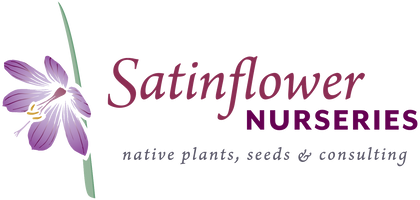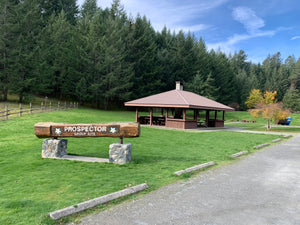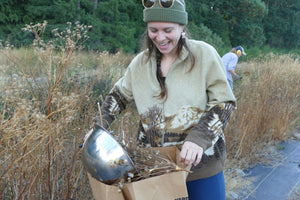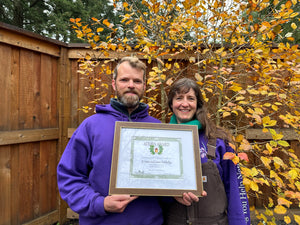Weekly with Daly: Mistaken Identity, Cow Parsnip

The Weekly with Daly is a regular column about the musings of the nursery written by our in-house wildlife observer and passionate conservationist, Julia Daly.
August 12th, 2022
Mistaken Identity: Cow Parsnip
Growing up to 3 meters in height, Cow Parsnip (Heracleum maximum) is a large, herbaceous perennial in the carrot family (Apiaceae). Its lush foliage and large compound umbels of numerous tiny white flowers make an impactful addition to gardens, hedgerows and restoration sites while benefiting an impressive range of pollinating insects and other wildlife (Figures 1, 2, 3, 4, 6).

Figure 1. Cow Parsnip umbels measure 15-20 cm in diameter and are a rich source of nectar for pollinators.
Cow Parsnip is the only member of the genus Heracleum native to North America. It grows from sea level to subalpine elevations throughout coastal British Columbia, preferring moist soils in full sun to part shade environments like stream banks, tidal marshes, upper beaches, meadows, roadsides and thickets. Named “YOLE” in the SENĆOŦEN language, Cow Parsnip has a rich history of use by the WSÁNEĆ People and many other First Nations on the Northwest Coast.

Figure 2. Pacific Chorus Frog (Pseudacris regilla) resting on Cow Parsnip leaf.
Unfortunately, Cow Parsnip is often confused for *Giant Hogweed (Heracleum mantegazzianum), an even larger (up to 5 meters tall) invasive perennial native to southwestern Asia, now found in BC on the Lower Mainland and Vancouver Island. While similar in many respects, several differences help differentiate these two species (table 1).
|
Cow Parsnip (H. maximum) |
Giant Hogweed (H. mantegazzianum) |
|
|
Leaves |
|
|
|
Stems |
|
|
|
Flowers |
|
|
|
Fruits |
|
 |
Table 1. Identifying characteristics of Cow Parsnip and Giant Hogweed.
Like Giant Hogweed, the inner sap of Cow Parsnip contains furanocoumarins (light-sensitive organic chemical compounds) that can cause blistering if in contact with skin. For this reason, some may be hesitant to plant Cow Parsnip. However, if care is taken to sow this plant in low-traffic areas where the risk of physically breaking foliage with exposed skin is minimal, Cow Parsnip makes a safe, deer-resistant choice for mesic to moist sites. Be respectful, not fearful, of this spectacular plant and consider including Cow Parsnip in your habitat restoration plans. Wildlife will thank you.

Figure 3. Caterpillar of Anise Swallowtail butterfly (Papilio zelicaon) feeding on Cow Parsnip leaf. This species prefers to lay eggs on plants in the carrot family, like Spring Gold (Lomatium utriculatum), Barestem Desert-parsley (Lomatium nudicaule), and Cow Parsnip for their larval hosts.

Figures 4. Cow Parsnip blooms from May to June and attracts a diversity of pollinators, including this Cedar Hairstreak (Mitoura rosneri plicata).

Figure 5. Flowers ripen to flat, heart-shaped seeds in July.

Figure 6. Cow Parsnip growing in a streamside thicket alongside Nootka Rose (Rosa nutkana).
I hope you’ve enjoyed this Weekly with Daly,
Signing off,
Julia
* If you’ve seen Giant Hogweed in your community, consider using an app like iNaturalist to identify and map the plants. You can also make a report on the Invasive Species Council of BC website (https://bcinvasives.ca/invasives/giant-hogweed/), the Report Invasives BC app (https://apps.apple.com/us/app/report-invasives-bc/id1004208197), or directly to the BC government using this form (https://forms.gov.bc.ca/industry/report-an-invasive-species/).*
Seeds of Cow Parsnip are available now at our nursery!
Book and Electronic references:
Gucker, Corey. (2009). Heracleum mantegazzianum. In Fire Effects Information System. US Department of Agriculture, Forest Service, Rocky Mountain Research Station, Fire Sciences. https://www.fs.fed.us/database/feis/plants/forb/herman/all.html [2021, August 11.]
Invasive Species Council of BC. (2022) Giant Hogweed: Heracleum mantegazzianum. https://bcinvasives.ca/invasives/giant-hogweed/. [Accessed 2021, August 11].
Klinkenberg, Brian. (Editor). 2021. Heracleum maximum. E-Flora BC: Electronic Atlas of the Wildlife of British Columbia. Lab for Advanced Spatial Analysis, Department of Geography, UBC, Vancouver. https://linnet.geog.ubc.ca/Atlas/Atlas.aspx?sciname=Heracleum%20maximum&redblue=Both&lifeform=7. [Accessed 2021, August 4]
Klinkenberg, Brian. (Editor). 2021. Heracleum mantegazzianum. E-Flora BC: Electronic Atlas of the Wildlife of British Columbia. Lab for Advanced Spatial Analysis, Department of Geography, UBC, Vancouver. https://linnet.geog.ubc.ca/Atlas/Atlas.aspx?sciname=Heracleum%20mantegazzianum&redblue=Both&lifeform=7. [Accessed 2022, August 4].
Klinkenberg, Brian. (Editor). 2021. Papilio zelicaon. E-Fauna BC: Electronic Atlas of the Wildlife of British Columbia. Lab for Advanced Spatial Analysis, Department of Geography, UBC, Vancouver. http://linnet.geog.ubc.ca/efauna/Atlas/Atlas.aspx?sciname=Papilio%20zelicaon. [Accessed 2022, August 11].
Page, N.A et al. (2005). The Biology of Invasive Alien Plants in Canada. 4. Heracleum mantegazzianum. Canadian Journal of Plant Science. 86(2):569-589. https://cdnsciencepub.com/doi/pdf/10.4141/P05-158. [Accessed 2022, August 4].
Page N. & Wall, R. (2003). Heracleum mantegazzianum (Giant Hogweed): A Nasty Invasive Plant Species in British Columbia. Botanical Electronic News. http://bomi.ou.edu/ben314.html. [Accessed 2021, August 4].
Pojar, J. & Mackinnon, A. (2014). Plants of Coastal British Columbia. BC Ministry of Forests and Lone Pine.
Turner, N. & Hebda, H. (2012). Saanich Ethnobotany: Culturally Important Plants of the WSÁNEĆ People. Royal BC Museum.
Illustrations:
Leaf and seed illustrations by Julia Daly
- Tags: Weekly with Daly
- Satinflower Nurseries









